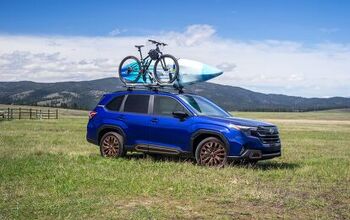2024 Lincoln Nautilus First Drive Review: Big Screen Debut

2024 Lincoln Nautilus Quick Take
Wholly new for this year and stuffed full of tech, the 2024 Lincoln Nautilus takes on the likes of the Lexus RX with a whole-hearted comfort angle, providing buyers with a cushy cabin and tech meant to make life easy.
While the pillar-to-pillar screen dominates the cabin, it doesn't transform the daily grind by as much as you might think.
It’s impossible to ignore the four-foot screen in the 2024 Lincoln Nautilus.
While there’s a whole lot of newness baked into Lincoln’s ‘tweener for ’24, a 48-inch screen has a way of overshadowing dang near everything. Tech evangelists will praise it; those opposed will hold it up as an example of all that is wrong with modern automotive cabin design.
The reality is somewhere in between: a lot of potential, but not all of it realized quite yet. Which, as I find after a few days of threading numerous Nautilus models around Canada’s Maritimes, applies to the Nautilus as a whole.
What’s new for 2024?
Just about everything. With the Ford Edge bowing out in North America—and the Oakville, Ontario plant which built both vehicles set to idle—the Nautilus rides on a unique platform on these shores. This also means this American luxury SUV is now built in China. Measurements are up in most every direction: 3.2 inches (82 millimeters) more length, 2.0 inches (50 mm) of added wheelbase, and about an inch (25 mm) more width and height for good measure. The Nautilus remains the larger of Lincoln’s two-row offerings.
The sheetmetal draping these larger dimensions is itself a big departure. Gone is the soft, rounded styling of yore, with a pair of sharper headlights framing the larger, squared-off grille. The light signature intersects the latter, which now features a light-up logo because of course it does. There’s a graceful arc to the roofline that invites Aviator comparisons, and big 22-inch alloy wheels make a strong statement. The rear end is all minimalism, a tidy full-width taillight setup and body-colored lower bumper keeping the look clean. As far as two-box designs go, this is a good one, especially in profile. In the two-tone designs found on the launch event, new Nautilus looks sharp without being so different as to scare off existing buyers.
Powertrain and efficiency: Pair of fours
The base Nautilus engine is largely the same as before: a 2.0-liter turbocharged four-cylinder sending 250 horsepower and 280 pound-feet to all four wheels through an eight-speed automatic. Those on-paper stats have it trailing the popular Lexus RX 350, but out in the real world the Nautilus never felt out of its depth. The rolling hills of Prince Edward Island are handled without issue, the Lincoln easily getting up to and maintaining a comfortable, set pace. The eight-speed does the right thing by fading into the background, only really making itself known when goosing the right pedal—and even then, it’s more auditory than anything else. With AWD now standard, even the efficiency is pretty solid: official figures are 21 mpg city and 29 mpg highway, for a combined 24 mpg rating. Canadian figures are 11.2, 8.1, and 9.8 L/100 km, respectively. Our drives are almost optimal with little traffic, allowing the Nautilus to beat those official figures.
If that sort of efficiency is your bag, Lincoln will also sell you a hybrid Nautilus. This setup effectively replaces the old turbo V6: it’s also a 2.0-liter turbo-four, but paired with an 100-kW electric motor for a combined 310 hp. Out goes the 8AT, in comes an eCVT—not a traditional belts-and-pulleys CVT, a Lincoln engineer was eager to point out. This is a gear-driven system, with proper mechanical AWD instead of the e-AWD found on the aforementioned Lexus.
On these roads there’s not much in it between these two powertrains: at speed the hybrid is barely quicker, and contends with additional weight. It’s the low-speed stuff where the electrified model excels, providing ample torque right away. There is less noise too, which feels appropriate for a luxury model: the two propulsion systems can work in sync, and the hand-off between them takes just two-tenths of a second when alternating. Fuel economy isn’t massively better: we’re talking 30/31/30 mpg (7.9/7.6/7.7 L/100 km), but that’s still an improvement on top of more power.
Handling and drivability: At arm’s length
A squircle. That’s the only way to describe the Nautilus’ squared-off steering wheel. As Lincoln tells it, it’s to maximize the visibility of the screen; like the new Prius, it works best if you set the wheel low, which feels counter-intuitive at first but quickly becomes comfortable. What doesn’t jive is the almost complete lack of feedback from the wheel. I’m not expecting Porsche or even Mazda levels of interaction here—this is a luxury SUV, after all—but paired with the variable ratio steering and squircle shape, the Nautilus’ helm does not inspire confidence. I know the wheels are turning, but I’m left second-guessing the amount of lock on longer corners, with either powertrain.
The rest of the package is much better. The brake pedal is smooth and progressive, ably hauling the Nautilus down on steeper downhill sections. As we load the fleet onto the ferry for the ride back to the mainland, the Nautilus is super-easy to precisely place in the tight quarters. The footwell does seem tight, as my shoe catches on the firewall a few times.
Ride quality and comfort: Coddle club
The roads snaking along the coasts of Nova Scotia and New Brunswick are littered with ruts and bumps. I pre-emptively wince when looking at the optional 22-inch wheels found on just about every tester here. But the thumps never come. A triple threat of active noise cancellation, acoustic glass, and even foam-filled tires combine for suitably hush-hush progress. The suspension tuning plays its part well too, with a soft, cosseting ride that stops short of ever feeling wallowy. Big compressions are smoothed out, resulting in a satisfying ride that keeps us feeling fresh on what is a long drive day.
There are selectable drive modes including Excite, which adds a little steering resistance, perks up the throttle responses, and tightens up the adaptive suspension. It’s suitably subtle, though I can’t imagine many buyers will ever explore it.
Interior style and quality: Looks good, feels fine
The Nautilus cabin is a mixed bag. Looking beyond the big screen—more on that later—the design is nicely low-profile and tasteful. The dashboard is all soft-touch, but the wraparound portions feature a big gap between door and dash, and don’t entirely align either. The black plastic panels dull the shine too—even though they’re, uh, shiny. The pretty switchgear is a great touch, though the gear selectors are only buttons.
The highlight of many modern Lincolns has to be the 24-way adjustable front seats, and the Nautilus follows suit. Sure, it takes a while to set up, but tailoring the seat to your exact needs is an underrated aspect of actual luxury. Heating and ventilation are both present and very effective. While the rear seats don’t have that level of customization, there’s plenty of room for adults, and a prodigious amount of storage space behind.
Tech and safety: Big screen, little issues
To hear Lincoln explain it, that mega-screen is to minimize eyes-off-the-road time. A pure display, the near-side two-fifths are for the driver, providing the typical info and navigation when active. The rest of the screen can be tailored with a few widgets—just seven at the launch—including weather, audio, and such. Choosing them is done via the 11.1-inch touchscreen, flinging the widget into a slot.
Unfortunately, Lincoln has joined the complicating-easy-tasks club by making air vent adjustments through the touchscreen only. Why?! Not only does it pull attention away from the road, it’s a lot less precise on the move. There are other touchscreen foibles too: there’s no audio shortcut, so unless you’re at the home screen it’s at least two taps away. Other journos had issues with the voice commands, but other than a general over-eagerness, we found it worked well enough. So does wireless Android Auto and Apple CarPlay for that matter.
BlueCruise is standard-fit here, and while there aren't many places to test it in the Maritimes, it works reasonably well when we get the chance. My co-driver does have one instance of the system ignoring a road line and continuing to arc left towards a barrier mind you—with a quick correction, of course.
Value, dollars, and sense
Pricing for the Nautilus spans a wide range. The lowest rung is the $52,010 (including destination) Premiere, which comes standard with BlueCruise, that big ol’ screen, and a full list of standard safety kit. The Reserve ($56,445 / $64,395 CAD) is the basis for our testers, and is the only flavor of Nautilus in Canada for now. Adding the pricey Reserve III package ($10,005 / $12,750 CAD) brings in all the comfort goodies like the infinitely adjustable seats with massage function and the excellent Revel audio system. A Black Label adds a chunky $19,500 on top of the Reserve’s starting price.
The hybrid adds $1,500 in America, but $3,500 CAD in Canada.
2024 Lincoln Nautilus Review: Final thoughts
To Lincoln’s credit, the Nautilus now feels very much like a distinct personality within the brand. Not only that, its distinctly comfort-first mindset, from its ride to those precise, massaging seats, does the same thing for it in the overall class. I’m not yet sold on the functionality of that headlining screen, nor the inconsistent quality of the cabin materials, but at least one of those can be improved via software. For discerning buyers who want a handsome two-row that truly pampers, the Nautilus is more than a numbers game.
Become an AutoGuide insider. Get the latest from the automotive world first by subscribing to our newsletter here.
Pros | Cons |
|---|---|
Pampering seats | Infotainment foibles |
Comfort-first driving experience | Feel-free steering |
Excellent audio system | Gets pricey quick |
2024 Lincoln Nautilus FAQs
- Q: How much horsepower does the 2024 Lincoln Nautilus have?
- A: The standard engine has 250 horsepower; the Nautilus hybrid bumps that to 310 hp.
- Q: What changed for the 2024 Lincoln Nautilus?
- A: The latest Nautilus has a new platform, more space, and a standard 48-inch screen stretched across the dashboard.
- Q: How much does a 2024 Lincoln Nautilus cost?
- A: The new Nautilus starts at $52,010 ($64,295 CAD) including destination.
2024 Lincoln Nautilus | |
|---|---|
Engine: | 2.0L I4 Turbo (w/ hybrid) |
Outputs: | 250 hp, 280 lb-ft / 310 hp (hybrid) |
Transmission: | 8AT/e-CVT, AWD |
US Fuel Economy (mpg): | 21/29/24 / 31/30/31 |
CAN Fuel Economy (L/100 km): | 11.2/8.1/9.8 / 7.9/7.6/7.7 |
Starting Price (USD): | $52,010 (inc. dest.) |
As-Tested Price (USD): | N/A |
Starting Price (CAD): | $64,295 (inc. dest.) |
As-Tested Price (CAD): | See text |

Kyle began his automotive obsession before he even started school, courtesy of a remote control Porsche and various LEGO sets. He later studied advertising and graphic design at Humber College, which led him to writing about cars (both real and digital). He is now a proud member of the Automobile Journalists Association of Canada (AJAC), where he was the Journalist of the Year runner-up for 2021.
More by Kyle Patrick







































Comments
Join the conversation